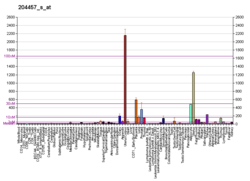GAS1
Growth arrest-specific protein 1 is a protein that in humans is encoded by the GAS1 gene.[5][6]
Growth arrest-specific 1 plays a role in growth suppression. GAS1 blocks entry to S phase and prevents cycling of normal and transformed cells. Gas1 is a putative tumor suppressor gene.[6]
References
- 1 2 3 GRCh38: Ensembl release 89: ENSG00000180447 - Ensembl, May 2017
- 1 2 3 GRCm38: Ensembl release 89: ENSMUSG00000052957 - Ensembl, May 2017
- ↑ "Human PubMed Reference:".
- ↑ "Mouse PubMed Reference:".
- ↑ Evdokiou A, Webb GC, Peters GB, Dobrovic A, O'Keefe DS, Forbes IJ, Cowled PA (Mar 1994). "Localization of the human growth arrest-specific gene (GAS1) to chromosome bands 9q21.3-q22, a region frequently deleted in myeloid malignancies". Genomics. 18 (3): 731–3. doi:10.1016/S0888-7543(05)80388-X. PMID 8307588.
- 1 2 "Entrez Gene: GAS1 growth arrest-specific 1".
Further reading
- Del Sal G, Ruaro ME, Philipson L, Schneider C (1992). "The growth arrest-specific gene, gas1, is involved in growth suppression". Cell. 70 (4): 595–607. doi:10.1016/0092-8674(92)90429-G. PMID 1505026.
- Wicking C, Breen M, Negus K, et al. (1994). "The human growth-arrest-specific gene GAS1 maps outside the candidate region of the gene for nevoid basal cell carcinoma syndrome". Cytogenet. Cell Genet. 68 (1–2): 119–21. doi:10.1159/000133904. PMID 7956349.
- Del Sal G, Collavin L, Ruaro ME, et al. (1994). "Structure, function, and chromosome mapping of the growth-suppressing human homologue of the murine gas1 gene". Proc. Natl. Acad. Sci. U.S.A. 91 (5): 1848–52. doi:10.1073/pnas.91.5.1848. PMC 43261. PMID 8127893.
- Evdokiou A, Cowled PA (1998). "Tumor-suppressive activity of the growth arrest-specific gene GAS1 in human tumor cell lines". Int. J. Cancer. 75 (4): 568–77. doi:10.1002/(SICI)1097-0215(19980209)75:4<568::AID-IJC13>3.0.CO;2-5. PMID 9466658.
- Stebel M, Vatta P, Ruaro ME, et al. (2000). "The growth suppressing gas1 product is a GPI-linked protein". FEBS Lett. 481 (2): 152–8. doi:10.1016/S0014-5793(00)02004-4. PMID 10996315.
- Lee CS, Buttitta L, Fan CM (2001). "Evidence that the WNT-inducible growth arrest-specific gene 1 encodes an antagonist of sonic hedgehog signaling in the somite". Proc. Natl. Acad. Sci. U.S.A. 98 (20): 11347–52. doi:10.1073/pnas.201418298. PMC 58732. PMID 11572986.
- Baladrón V, Ruiz-Hidalgo MJ, Bonvini E, et al. (2002). "The EGF-like homeotic protein dlk affects cell growth and interacts with growth-modulating molecules in the yeast two-hybrid system". Biochem. Biophys. Res. Commun. 291 (2): 193–204. doi:10.1006/bbrc.2002.6431. PMID 11846389.
- Mellström B, Ceña V, Lamas M, et al. (2002). "Gas1 is induced during and participates in excitotoxic neuronal death". Mol. Cell. Neurosci. 19 (3): 417–29. doi:10.1006/mcne.2001.1092. PMID 11906213.
- Strausberg RL, Feingold EA, Grouse LH, et al. (2003). "Generation and initial analysis of more than 15,000 full-length human and mouse cDNA sequences". Proc. Natl. Acad. Sci. U.S.A. 99 (26): 16899–903. doi:10.1073/pnas.242603899. PMC 139241. PMID 12477932.
- Xu Y, Kulkosky J, Acheampong E, et al. (2004). "HIV-1-mediated apoptosis of neuronal cells: Proximal molecular mechanisms of HIV-1-induced encephalopathy". Proc. Natl. Acad. Sci. U.S.A. 101 (18): 7070–5. doi:10.1073/pnas.0304859101. PMC 406467. PMID 15103018.
- Cabrera JR, Sanchez-Pulido L, Rojas AM, et al. (2006). "Gas1 is related to the glial cell-derived neurotrophic factor family receptors alpha and regulates Ret signaling". J. Biol. Chem. 281 (20): 14330–9. doi:10.1074/jbc.M509572200. PMID 16551639.
This article is issued from
Wikipedia.
The text is licensed under Creative Commons - Attribution - Sharealike.
Additional terms may apply for the media files.





